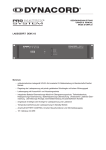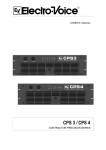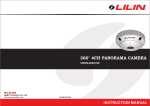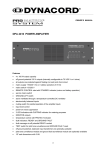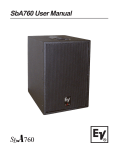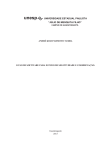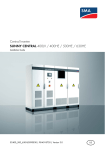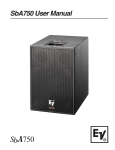Download Dynacord DEM 313 User's Manual
Transcript
OWNER’S MANUAL CHARGING UNIT DEM 313 Features — fully automatic charging unit 24V/4A for constant I/U battery charging in continuous battery power supply mode — regulation of charging voltage with high-efficiency primary switched chopper regulator — charging output with short-circuit and reverse voltage protection — integrated battery monitoring module with overvoltage protection, exhaustive discharge protection, mains voltage monitoring, battery voltage monitoring, charging circuit monitoring, LED fault indicator, collective failure information via floating contact — integrated 3-digit LC display showing charging voltage and charging current — temperature tracking of charging voltage in standby mode — connector BATTERY CONTROL with all control functions and failure indication output — 19" enclosure with 2HU IMPORTANT SAFETY INSTRUCTIONS The lightning flash with arrowhead symbol, within an equilateral triangle is intended to alert the user to the presence of uninsulated “dangerous voltage” within the product’s enclosure that may be of sufficient magnitude to constitute a risk of electric shock to persons. The exclamation point within an equilateral triangle is intended to alert the user to the presence of important operating and maintance (servicing) instructions in the literature accompanying the appliance. 1. 2. 3. 4. 5. 6. 7. 8. 9. 10. Read these instructions. Keep these instructions. Heed all warnings. Follow all instructions. Do not use this apparatus near water. Clean only with a damp cloth. Do not block any of the ventilation openings. Install in accordance with the manufactures instructions. Do not install near any heat sources such as radiators, heat registers, stoves, or other apparatus that produce heat. Only use attachments/accessories specified by the manufacturer. Refer all servicing to qualified service personnel. Servicing is required when the apparatus has been damaged in any way, such as power-supply cord or plug is damaged, liquid has been spilled or objects have fallen into the apparatus, the apparatus has been exposed to rain or moisture, does not operate normally, or has been dropped. For US and CANADA only: Do not defeat the safety purpose of the grounding-type plug. A grounding type plug has two blades and a third grounding prong. The wide blade or the third prong are provided for your safety. When the provided plug does not fit into your outlet, consult an electrican for replacement of the absolete outlet. IMPORTANT SERVICE INSTRUCTIONS CAUTION: These servicing instructions are for use by qualified personnel only. To reduce the risk of electric shock, do not perform any servicing other than that contained in the Operating Instructions unless you are qualified to do so. Refer all servicing to qualified service personnel. 1. Security regulations as stated in the EN 60065 (VDE 0860 / IEC 65) and the CSA E65 - 94 have to be obeyed when servicing the appliance. 2. Use of a mains separator transformer is mandatory during maintenance while the appliance is opened, needs to be operated and is connected to the mains 3. Switch off the power before retrofitting any extensions, changing the mains voltage or the output voltage. 4. The minimum distance between parts carrying mains voltage and any accessible metal piece (metal enclosure), respectively between the mains poles has to be 3 mm and needs to be minded at all times. The minimum distance between parts carrying mains voltage and any switches or breakers that are not connected to the mains (secondary parts) has to be 6 mm and needs to be minded at all times. 5. Replacing special components that are marked in the circuit diagram using the security symbol (Note) is only permissible when using original parts. 6. Altering the circuitry without prior consent or advice is not legitimate. 7. Any work security regulations that are applicable at the location where the appliance is being serviced have to be strictly obeyed. This applies also to any regulations about the work place itself. 8. All instructions concerning the handling of MOS - circuits have to be observed. Note: SAFETY COMPONENT (HAS TO BE REPLACED WITH ORIGINAL PART ONLY) 14 1 3-digit LC display for charging voltage or charging current 2 LC display switch showing the charging voltage in V or the charging current in A 3 LED function and failure indications: Failure indication for overvoltage OVERVOLTAGE Failure indication for low voltage LOW VOLTAGE Function indication for mains voltage LINE VOLTAGE Function indication for battery voltage BATTERY VOLTAGE Function indication for charging current 4. Fuse for mains output socket 5 Mains output socket MAINS OUTPUT 6 Fuse for the mains input 7 Mains input socket 8 CHARGE OUTPUT 9 Sub-D socket BATTERY CONTROL CHARGE CURRENT 15 LIST OF CONTENTS SAFETY INSTRUCTIONS / SERVICE INSTRUCTIONS . . . . . . . . . . . . . . . . . . . . . . . . . . . . . 14 1. Application . . . . . . . . . . . . . . . . . . . . . . . . . . . . . . . . . . . . . . . . . . . . . . . . . . . . . . . . . . . . 17 2. Installation instructions . . . . . . . . . . . . . . . . . . . . . . . . . . . . . . . . . . . . . . . . . . . . . . . . . . . 17 3. Before commissioning . . . . . . . . . . . . . . . . . . . . . . . . . . . . . . . . . . . . . . . . . . . . . . . . . . . 17 3.1 Sub-D socket BATTERY CONTROL . . . . . . . . . . . . . . . . . . . . . . . . . . . . . . . . . . . . . . . . 18 4. Changing mains voltage . . . . . . . . . . . . . . . . . . . . . . . . . . . . . . . . . . . . . . . . . . . . . . . . . . 18 5. Battery charging . . . . . . . . . . . . . . . . . . . . . . . . . . . . . . . . . . . . . . . . . . . . . . . . . . . . . . . . 19 5. 1 Charging the batteries in the battery modules DEM 316 or DEM 317 . . . . . . . . . . . . . . . 19 5. 2 Charging other batteries . . . . . . . . . . . . . . . . . . . . . . . . . . . . . . . . . . . . . . . . . . . . . . . . . . 20 6. Description of function and operation . . . . . . . . . . . . . . . . . . . . . . . . . . . . . . . . . . . . . . . . 20 6.1 OVERVOLTAGE protection . . . . . . . . . . . . . . . . . . . . . . . . . . . . . . . . . . . . . . . . . . . . . . . 21 6.2 LOW VOLTAGE monitoring . . . . . . . . . . . . . . . . . . . . . . . . . . . . . . . . . . . . . . . . . . . . . . . 21 6.3 LINE VOLTAGE monitoring . . . . . . . . . . . . . . . . . . . . . . . . . . . . . . . . . . . . . . . . . . . . . . . 21 6.4 BATTERY VOLTAGE monitoring . . . . . . . . . . . . . . . . . . . . . . . . . . . . . . . . . . . . . . . . . . . 21 6.5 CHARGE CURRENT monitoring . . . . . . . . . . . . . . . . . . . . . . . . . . . . . . . . . . . . . . . . . . . 21 6.6 Protection against reverse voltage and short circuit . . . . . . . . . . . . . . . . . . . . . . . . . . . . . 21 6.7 Collective failure indication . . . . . . . . . . . . . . . . . . . . . . . . . . . . . . . . . . . . . . . . . . . . . . . . 21 6.8 Volt/Ampere meter . . . . . . . . . . . . . . . . . . . . . . . . . . . . . . . . . . . . . . . . . . . . . . . . . . . . . . 22 6.9 Temperature tracking . . . . . . . . . . . . . . . . . . . . . . . . . . . . . . . . . . . . . . . . . . . . . . . . . . . . 22 7. Fuses . . . . . . . . . . . . . . . . . . . . . . . . . . . . . . . . . . . . . . . . . . . . . . . . . . . . . . . . . . . . . . . . 22 8. Glossary . . . . . . . . . . . . . . . . . . . . . . . . . . . . . . . . . . . . . . . . . . . . . . . . . . . . . . . . . . . . . . 22 9. Registrations and standards . . . . . . . . . . . . . . . . . . . . . . . . . . . . . . . . . . . . . . . . . . . . . . 23 10. Specifications of the charging unit DEM . . . . . . . . . . . . . . . . . . . . . . . . . . . . . . . . . . . . . . 23 16 1. Application The charging unit DEM 313 was especially designed for fully automatic charging and monitoring of batteries in the emergency power supplies of alarm devices. In conjunction with the battery modules DEM 316 with 38 Ah or DEM 317 with 65 Ah rated capacity, this combination results in a reliable and failsafe emergency power source for continuous battery power supply operation. The integrated monitoring module ensures permanent battery monitoring. 2. Installation instructions The airflow of the unit must not be blocked. The appliance must be protected against: - drip or splashwater - direct sun irradiation - high ambient temperature or direct influence of heat sources - high air humidity - heavy dust deposits - strong vibrations lf ihe unit is brought directly from a cold to a warm place, dampness can precipitate on the inner parts. The unit may only be put into operation after it has warmed up to the ambient temperature (approx. after one hour). Should an object or liquid get into the case, disconnect the unit from the current sources immediately and have the device checked by a DYNACORD service center, before further use. Do not use any sprays to clean the unit, as these can damage it, perhaps causing it to ignite suddenly. 3. Before commissioning Before connecting the unit to the mains, the following connections must be made: • The D-sub connector socket BATTERY CONTROL (9) of the charging unit ist to be connected with the D-sub connector BATTERY CONTROL of the battery module (also see Figure 1 and Section 3.1). • The CHARGE OUTPUT (8) of the charging unit is to be connected with the charging input CHARGE CURRENT of the battery module. Please observe correct polarity (see Figure 1). The cross-section of the line between the charging unit and the battery module must be at least 2.5mm2. Insulated AMP flat-pin sleeves 6.3x0.8 mm must be used for the connections. The line length must not exceed 2 m. • Another device can be connected at the mains connector MAINS OUTPUT (5), if its power consumption does not exceed 4 A. The mains connector MAINS OUTPUT (5) is protected against overloading by a fuse (4) with the rating T4A. A fuse rating above T4A is not admissible. • lf all connections have been made correctly, the unit can be connected with the mains by means of the supplied power cable. The mains cable is connected at the 3-pole mains connector socket (7) on the unit Attention: The unit is wired to 2 30V AC by the factory. Switching over to 115 V AC is possible via wire jumpers inside the unit, (see Section 4). 17 Fig. 1 Connection of the battery to the charging unit 3.1 Control connector BATTERY CONTROL Various control input/outputs are available at the 15-pole D-sub pin connector BATTERY CONTROL (9): (Also see Figure 2): - Input temperature sensor +TEMP/-TEMP - Output exhaustive discharge relay +LVR/-LVR - Failure signal output FAILURE Fig. 2 Connections of the BATTERY CONTROL pin connector Note The switch rating of the failure signal output amounts to max. 30V dc / 0.IA . The contacts 2, 3 and 13 are provided for test purposes only and must not be used. 4. Alteration of the mains voltage (to be performed by qualified personnel only) Attention: Before removing the top unit cover, the device must have been disconnected from the mains for at least 2 minutes, since the capacitors in the device carry hazardous voltage which needs to discharge first. For 115V AC operation, the mains powerfuse (6) must be replaced by a fuse 2A slo-blo (T2A). A T2A label must be stuck over the T1 A marking above the mains power fuse (6). A 115V label must be stuck over the marking 230V above the mains connector (7). The necessary labels are to be found inside the unit on the right adjacent to the PCB 85254. For alteration to 115V AC operation, the wire jumpers S501, S502 and S504 on the PCB 85254 are to be soldered in and the wire jumper S 503 must be removed, (see Figure 3). 18 F 503 S 504 S 503 S 502 Fig. 3 PCB 85254 Location of the wire jumpers S501 - S504 for altering mains voltage and position of the output fuse F503 5. Battery charging 5.1 Charging the batteries in the battery modules DEM 316 or DEM 317 Once the charging unit has been connected to the battery module correctly, (see Section 3) and the mains voltage is present the green LEDs (3) LINE VOLTAGE, BATTERY VOLTAGE and CHARGE CURRENT light up. The charging current is indicated on the LC display (1), if switch (2) is in position A. The battery is charged with constant charging current of approx. 4 A. As charging is completed, the charging current decreases rapidly with rising back-e.m.f. of the battery. At the end of charging, the charging current falls to a small floating current of approx. 1 mA/Ah of the capacity of the battary to the loaded, a value which is permanently compatible for the battery. This value can vary with older batteries in particular, amounting to between 0.5 mA and 10 mA per Ah. Note: lf the connection is faulty, there is no charging current and the green LED (3) CHARGE CURRENT does not light up. Please check all connections between the battery and the charging unit, all fuses and the mains voltage. The capacity retention of the battery takes place with a constant voltage of 27.3 V at 20°C. The charging voltage is indicated by the LC display (1), if swith (2) is in position V. lf the ambient temperature deviates from +20°C in standby mode, the charging voltage is adapted automatically, depending on the temperature. The temperature coefficient amounts to -40 mV/°C for a 24 V battery. Note: The charging unit is designed for the connection to one battery module. A parallel connection of batteries is not recommended. Batteries connected in parallel cannot be monitored. Attention: The charging circuit fuses CHARGE FUSES of the battery modules DEM 315 and DEM 316 must be exchanged for 7.5 A fuses if the charging unit DEM 313 is used. In the event of a faulty fuse, no charging current flows and the green LED (3) CHARGE CURRENT does not light up. 19 S 501 - max. value - rated value - min. value 5.2 Charging of other batteries DYNACORD battery modules DEM 316, DEM 317 or other maintenance - free 24V lead-acid batteries with a rated capacity up to 65 Ah can be charged with the charging unit DEM 313. To do so, the charging output CHARGE OUTPUT + (8) is to be connected with the plus pole and the charging output CHARGE OUTPUT - (8) with the negative pole of the battery respectively. For temperature tracking of Ihe charging voltage in standby mode, the temperature sensor (retrofitting kit NRS 90200) must be installed according to the retrofitting instructions and is to be connected with the charging unit (see also Figures 1, 2 and Sections 3.1, 6.9). In order to prevent exhaustive discharging of the battery, suitable relays must be used which are to be connected with the charging unit according to Figure 1 or Figure 2. The total coil resistance of the relays may not be below 70 ohms. Attention: VDE 0510 is to be observed for the installation of the batteries. Short-circuit-proof installation of battery cables must be observed in particular, and precautions against the risk of explosion must be taken. 6. Description of function and operation The charging unit DEM 313 is designed for constant I/U battery charging in continuous battery power supply mode. Primary switched circuit technology is used to generate a regulated charging voltage or charging current which has a high efficiency rate coupled with excellent regulation characteristics and good reliability. 20 6.1 OVERVOLTAGE protection This circuit monitors the value of the output voltage of the charging unit. lf the output voltage exceeds the pre-set upper threshold, the red LED OVERVOLTAGE lights up, the charging unit is disconnected from battery and consumers automatically, activating the error message. Thereby the battery remains connected to the consumer, supplying it until the failure has been remedied. This proection circuit prevents an inadmissible increase of the battery voltage and the resultant gassing of Ihe battery with a possible failure in the charging unit (protection against danger of explosion through detonating gas). 6.2 LOW VOLTAGE monitoring The battery voltage is monitored in the case of discharge. lf the voltage falls belowthe pre-set threshold of 22 V, the red LED LOW VOLTAGE lights up. Once the mains voltage is back, the battery is re-charged automatically. lf the battery voltage does not reach the adjusted threshold of 25.5 V within the given charging time of approx. 8 h after a mains failure, and the red LED LOW VOLTAGE does not go out this probably means a battery malfunction and an error message is activated. 6.3 LINE VOLTAGE monitoring The green LED LINE VO LTAGE goes off in the case of mains failure and an error message is activated. 6.4 BATTERY VOLTAGE monitoring The battery voltage is monitored with this circuit. lf the battery is alright the green LED BATTERY VOLTAGE lights up. lf the battery voltage drops below the value of 19.5 V, the battery is discharged, all LEDs are off, an error message is activaed, the battery is disconnected from all consumers and thus reliably protected against exhaustive discharging. The exhaustive discharge protection only works with the battery modules DEM 315, DEM 316 and DEM 317 (also see Sections 5.1 and 5.2). 6.5 CHARGE CURRENT monitoring This monitors the function of the battery circuit (e.g. cable break or similar). lf the battery charging current falls below the adjusted value of approx. 10 mA, the green LE D (3) CHARGE CURRENT goes out and an error message is activated. lf there is no load connected to the battery, the battery charging current may fall below this limiting value. In such cases it is advisable to connect a resistor of 2200 ohms to the battery output. 6.6 Reverse voltage and short-circuit protection Reverse volltage protection prevents damage which may be caused by possible polarisation errors when the battery is connected to the charging unit. The short-circuit protection disconnects the battery from the charging unit in the event of shorted cells or total short-circuit. The output fuse F 503 (see Figure 3) in the charging unit blows in this case and must be replaced by a slo-blo fuse with the rating 4A (T4A). In the event of a blown fuse, the green LED (3) CHARGE CURRENT goes out and an error message is activated. 6.7 Collective failure signal The collective failure signal is designed as a floating contact, making available malfunctions of the battery such as: disconnection at LOW VOLTAGE, wrong polarity or battery short-circuit, as well as malfunctions of the charging unit such as: absence of LINE VOLTAGE, OVERVOLTAGE or failures in the charging circuit CHARGE CURRENT for long-range transmission. The corresponding failure is indicated on the unit itself via the corresponding LED (3) lighting up or going off respectively,(see page 2 as well as Section 6.1 to 6.6). The floating contact of the collective failure indication is wired at the D-sub pin connector BATTERY CONTROL (9) (see Figure 2). 21 6.8 Volt-/Amperemeter A 3-digit LC display (1) with toggle switch (2) is provided for measurement of the battery voltage or the charging current. With the switch V/A at the front panel in position V, the battery vollage is shown. Likewise the charging current is shown with the switch in position A. 6.9 Temperature tracking The charging voltage requires battery-adapted temperature tracking in conjunction with operation under ambient temperatures between +5°C .. +40°C. The temperature is to be measured in direct proximity to the battery. The temperature tracking feature consists of a temperature sensor, integrated in the battery module DEM 316 or DEM 317 which must be installed in direct proximity to the battery, and a control circuit in the charging unit. The sensor is connected to the charging unit via the 15-pole pin connector BATTERY CONTROL. The control circuitis activated if the temperature sensor has been connected correctly. lf the connection of the temperature sensor is faulty of there is a short-circuit or a break of the sensor lines or of the sensor, this interupts battery charging and the collective failure signal is activated. The retrofitting kit NRS 90200 is to be used for the battery module DEM 315 or other batteries and is available as Article no. 121 950. 7. Fuses The dimensions of all the fuses in the unit are 5 x 20 mm and must correspond with IEC 127. Fuse holder (4) Fuse holder (6) Fuse holder (6) PCB 85254, F503 mains power fuse for mains connector (see page 2) mains power fuse for 230V ac (see page 2) mains power fuse for 11 5V ac (see page 2) output fuse CHARGE OUTPUT (see Figure 3) T4A 250V T1A 250V T2A 250V T4A 250V 8. Glossary: - Continuous battery power supply (standby operation) In this mode, the battery is constantly kept at full charge. It only gives off current if the DC source supplied by the mains fails. - Nominal capacity: The nominal capacity is the value in ampere-hours for a 20-hour even, uninterrupted discharge with up to the cutoff voltage of 1.75 V/cell at a temperature of 22°C. - Capacity: The capacity of a battery is the amount of electricity which can be extracted under the condlitions in question. This depends on the discharge current, the cut-off voltage and the temperature. - Service life For batteries in alarm apparatus and emergency announcement systems, the end of a battery’s service life (limited duration of operation) is reached when the capacity is less than 80% of the rated capacity. - Stored energy time This is the time-span between recognition of a failure in the mains supply and remedying of this failure. - Alarm duration The alarm duration is the time-span during which the alarm signal is given out. - Emergency announcement duration This is the time during which announcements are made to clear the building or section of a building. 22 9. Approvals and standards - The charging units correspond to the following standards: EN 55014-2 Immunity requirements for household appliances, electric tools and similar electrical appliances EN 50082-1 Basic standard for interference rejection; living area, business areas as well as small enterprises EN 60065 Safety requirements for mains-operated electronic appliances and related accessories for house hold use and similar general application EN 60742 Regulations for isolation transformers and safety transformers 10. Specifications DEM 313 Mains voltage internally solderable to Safety class Rated output voltage Voltage adjustment for battery charging 2.275 V/cell Tolerance of the output voltage at 20°C Temperature coefficient of the charging voltage Ripple at nominal operation Static mains control at input deviations of +l 0% -15 % Nominal charging current Current limitation Standby current at power failure Switching frequency Efficiency Failure detection OVERVOLTAGE Failure detection at battery LOW VOLTAGE Failure detection at battery LOW VOLTAGE Failure detection at mains low voltage LINE VOLTAGE Failure detection at mains low voltage LINE VOLTAGE Switch-off at BATTERY VOLTAGE Failure detection at CHARGE CURRENT Operating temperature range Storage temperature Dimensions W x H x D Mounting depth without connectors Mounting depth with connectorsmax. Weight ≤ 0.05% 4A approx. 4 A 110 mA 88 kHz ±l0% approx. 83 % ≥ 29.6 V ≤ 25.5 V operation mode charging ≤ 22.0 V operation mode discharging 165 V ±15% for 230 V ac operation 83.5 V ±15% for 115 V ac operation ≤ 19.5 V ≤ 20 rrA +5″C + 40″C -40″C+ 70″C 483 x 88 x 335 mm 300 mm 350 mm 4.4 kg Retrofitting kit for DEM 313: NRS 90200 temperature sensor Art.No 121950 23 230 V +10%/-15 % 50-60 Hz 115 V +10%/-15 % 50-60 Hz I 24 V 27.3 V ± 0.37 % -40 mV/°C ≤ 0.1%











